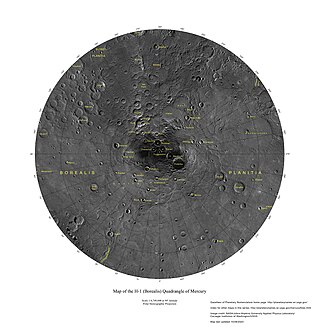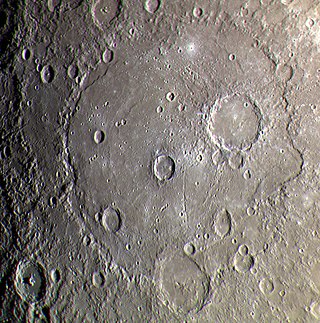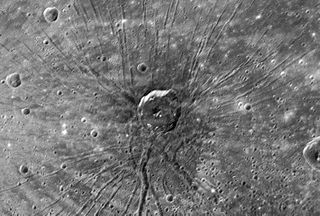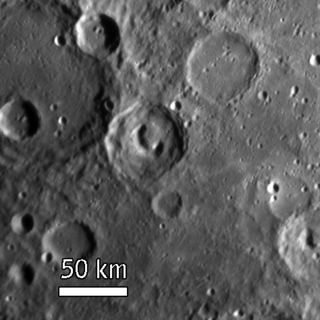
The Borealis quadrangle is a quadrangle on Mercury surrounding the north pole down to 65° latitude. It was mapped in its entirety by the MESSENGER spacecraft, which orbited the planet from 2008 to 2015, excluding areas of permanent shadow near the north pole. Only approximately 25% of the quadrangle was imaged by the Mariner 10 spacecraft during its flybys in 1974 and 1975. The quadrangle is now called H-1.

Beethoven is a crater at latitude 20°S, longitude 124°W on Mercury. It is 630 km in diameter and was named after Ludwig van Beethoven. It is the eleventh largest named impact crater in the Solar System and the third largest on Mercury.

Beagle Rupes is an escarpment on Mercury, one of the highest and longest yet seen. It was discovered in 2008 when MESSENGER made its first flyby of the planet. It has an arcuate shape and is about 600 km long. The scarp is a surface manifestation of a thrust fault, which formed when the planet contracted as its interior cooled.

Apollodorus is an impact crater on Mercury. Its unusual appearance, with radiating dark troughs, led to a nickname of "the Spider" by scientists before its official name was decided. Apollodorus is located near the center of Pantheon Fossae, which is a system of radial grabens situated in the inner part of the Caloris basin. The floor, rim and walls of Apollodorus expose a low reflectance material (LRM) excavated during the impact from beneath the light volcanic plains, which cover the central part of the Caloris.

Sveinsdóttir is a large impact crater on Mercury. Its dimensions are 220 × 120 km.

Praxiteles is a crater on Mercury. It is one of 110 peak ring basins on Mercury.

Moody is an impact crater on Mercury.

Navoi is a crater on Mercury. It contains uncommon reddish material that indicates a different rock composition from its surroundings. Navoi also appears to have an irregularly shaped depression in its center. Such depressions have been seen elsewhere on Mercury, including within Praxiteles crater, and may indicate past volcanic activity.

Raditladi is a large impact crater on Mercury with a diameter of 263 km. Inside its peak ring there is a system of concentric extensional troughs (graben), which are rare surface features on Mercury. The floor of Raditladi is partially covered by relatively light smooth plains, which are thought to be a product of the effusive volcanism. The troughs may also have resulted from volcanic processes under the floor of Raditladi. The basin is relatively young, probably younger than one billion years, with only a few small impact craters on its floor and with well-preserved basin walls and peak-ring structure. It is one of 110 peak ring basins on Mercury.

Gibran is a crater on Mercury and is in the east of the Shakespeare quadrangle. It was named after Lebanese-American poet Khalil Gibran in 2009. Gibran is located east of the rayed crater of Degas and nearby Damer.

Berkel is a crater on the planet Mercury. Its name was approved by the IAU on July 9, 2009. It was named after the modernist painter Sabri Berkel.

Izquierdo is a crater on Mercury located to the east of Beagle Rupes and Sveinsdóttir crater. The floor of Izquierdo is smooth, the result of having been partially filled with volcanic lava. Circular outlines of the rims of “ghost craters” – smaller, older craters that have been largely buried by the lavas that infilled the basin – are visible in a few places on Izquierdo's floor. The remnants of a buried inner ring are also barely discernible in spots, and it is one of 110 peak ring basins on Mercury. There have been more recent impacts into the floor of Izquierdo, resulting in some small, sharply defined craters.

Beckett is a pit-floored crater on Mercury, which was discovered in January 2008 during the first flyby of the planet by the MESSENGER spacecraft. The crater was named in November 2008 by the IAU.

Glinka is a pit-floored crater on Mercury, which was discovered in 1974 by Mariner 10 spacecraft. It was named by the IAU in 2008, after Russian composer Mikhail Glinka.

Scarlatti is a pit-floored crater on Mercury, which was discovered in 1974 by the Mariner 10 spacecraft. It has a prominent peak ring, and it is one of 110 peak ring basins on Mercury. The crater floor is covered by the smooth plains material. The crater displays an arcuate collapse feature along the northeastern peak ring. The size of the pit, which was first noticed in MESSENGER images obtained in January 2008, is 38 × 12 km. Such a feature may have resulted from collapse of a magma chamber underlying the central peak ring complex of the crater. The collapse feature is an analog of Earth's volcanic calderas. Scarlatti is thought to have the same age as the Caloris basin.

To Ngoc Van is a pit-floored crater on Mercury, named after the Vietnamese artist Tô Ngọc Vân. It was discovered in January 2008 during the first flyby of the planet by MESSENGER spacecraft. Its floor displays an irregularly shaped collapse feature, which is called a central pit. The size of the pit is 21 × 10 km. Such a feature may have resulted from collapse of a magma chamber underlying the central part of the crater. The collapse feature is an analog of Earth's volcanic calderas.

Picasso is a crater on Mercury. It has drawn scientific attention because of the large, arc-shaped pit crater located on the eastern side of its floor. Similar pits have been discovered on the floors of several other Mercury craters, such as Beckett and Gibran. These pits are postulated to have formed when subsurface magma subsided or drained, causing the surface to collapse into the resulting void. If this interpretation is correct, pit-floor craters such as Picasso provide evidence of shallow magmatic activity in Mercury's history.

Geddes is a crater on Mercury. It has a diameter of 84 kilometers. Its name was adopted by the International Astronomical Union (IAU) in 2010. Geddes is named for the Irish stained glass artist Wilhelmina Geddes, who lived from 1887 to 1955.
Ghost craters on the planet Mercury have tectonic features such as graben and wrinkle ridges. These features were formed by extensional and contractional forces originating in tectonic processes such as uplift and global contraction. The combination of graben and wrinkle ridges inside ghost craters found on Mercury has not been observed on any of the other terrestrial planets.

Enheduanna is a crater on Mercury. It has a diameter of 105 kilometers. Its name was suggested by Gagan Toor from India in a naming contest which was eventually adopted by the International Astronomical Union (IAU) on 2015. Enheduanna is named for the Sumerian poet Enheduanna. The craters Carolan, Kulthum, Karsh, and Rivera were also named as part of the contest.


















